The Act of Supremacy
The Act of Supremacy, passed in 1534, established King Henry VIII as the Supreme Head of the English Church. The Reformation Parliament of 1529-1536 approved the king's break with the see of Rome, as well as Henry's divorce and remarriage. In 1539 it was ordered that an English translation of the Bible be placed in every parish church in England.
The aged Bishop Fisher refused to subscribe to the Act of Supremacy, and hailed as a Catholic martyr, he received the support of the Pope, who promised to make him a Cardinal in reward for his heroic stand for the rights of the Church against the formidable monarch's wishes. Enraged and ruthless when opposed, Henry vowed that if a hat arrived to make him a cardinal, the Pope would find Fisher had no head on which to wear it. The Bishop stood bravely by his principles. On 17th June, 1535, he was found guilty of treason and sentenced to death.
Henry VIII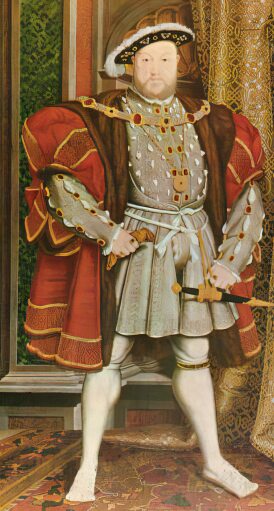
Sir Thomas More, Henry's Lord Chancellor and the author of Utopia, also refused to acknowledge the Act of Supremecy. Despite the pleadings of his family, he could not bring himself, in good conscience to subscribe to the Act. After a harsh term of imprisonment in the Tower, he was informed on the morning of 1st July, 1535, that he was to die later that day. More conducted himself with great courage and walked calmly to his execution wearing a coarse garment and holding a red cross. Thomas asked the Lord Lieutenant for help to mount the steps of the scaffold and joked "but as for my coming down again, let me shift for myself." Before laying his head on the block More loudly declared "I die the king's good servant, but God's first." His head joined that of Fisher on a pike on London Bridge, but was removed under cover of darkness by sympathizers.
The Fall of Anne Boleyn
Henry's affections, always volatile and unsteadfast, had strayed to one of Anne's ladies in waiting, Jane Seymour at Wulfhall, Wiltshire. Mistress Seymour, the daughter of a Wiltshire knight, prim, quiet and subservient, was the very antithesis of Henry's argumentative, loud and strong-willed wife, and in this probably lay her attraction to the king. Anne had promised him a son, but annoyingly had failed to deliver what he wanted and he was weary of heated arguments with her.
The queen was pregnant again, and Henry fervently hoped that this time it would be a son to succeed him. On January 24th, 1536, the 44-year-old King was unhorsed in a tournament at Greenwich Palace, the armour covered horse fell on top of him and he was badly injured and took quite a blow to the head. Knocked unconscious for around two hours, it seemed for a while that his life was in danger. When news of this accident reached the queen, she miscarried a male child that was about 15 weeks old, on the day of Catherine's funeral, 29 January 1536. Henry did not hide his displeasure with her failure, for most observers, this personal loss was the beginning of the end of the royal marriage. The recent death of Catherine of Aragon had rendered it possible for Henry to be rid of Anne without anticipating the prospect of again being married to Catherine. Ironically, while Catherine had lived, Anne remained safe in her position, Anne herself had long recognised the fact, declaring " she is my death and I am hers".
Anne was arrested and tried on a trumped-up charge of treason, for adultery with five men including her brother. It is unlikely that the charges against her had any basis. She defended herself at her trial with dignity and courage. A court controlled by Henry and presided over by Anne's uncle, Thomas Howard, Duke of Norfolk, pronounced her guilty. Anne was sentenced to be burned or beheaded at the king's pleasure. Disliked for her arrogant manner, there was no one to defend Anne. She stoutly maintained her innocence of the charges throughout. Deserted by everyone, she went to the block with courage. Rather than the execution is carried out by a clumsy axe, Henry had considerately brought over an expert swordsman from France to execute his wife. She was beheaded in the Tower on 19th May 1536, to enable the King to marry his new love, Jane Seymour. Her headless body, bundled into an arrow chest, was buried unceremoniously at the Chapel of St. Peter ad Vincula, within the Tower. Only days later, with unseemly haste, Henry married Jane.
Shap Abbey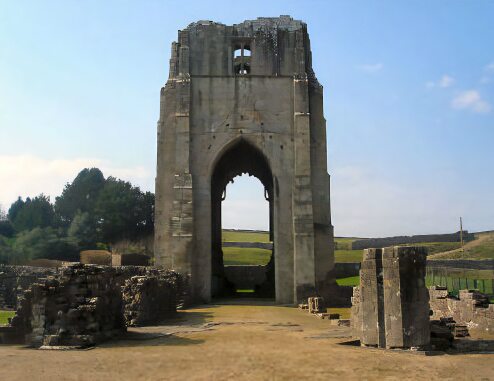
The Dissolution of the Monasteries and the Pilgrimage of Grace
Through the Dissolution of the Monasteries, Henry VIII appropriated the immense lands and riches of the church in England. The poor, who had benefited from the charity of the monasteries, suffered as a result, corrupt though the monasteries may have been they offered an education for the sons of the poor and a virtuous vocation for their daughters as well as performing many charitable acts. The confiscated monastic buildings and lands were sold to the rising gentry class, who were beginning to come to prominence under the Tudors.
Henry's minister, Thomas Cromwell was instrumental in carrying out the revolutionary changes. The north rose in protest under the leadership of Robert Aske, the Pilgrimage of Grace, as the rising was known, was put down with savage ferocity and its leaders went to the block. As a reward for his role in the Dissolution of the Monasteries, Henry created Thomas Cromwell Earl of Essex.
The Birth of an Heir
Jane Seymour was highly praised for her gentle, peaceful nature, being referred to as "gentle a lady as ever I knew" by John Russell and being named "the Pacific" by the Imperial Ambassador Eustace Chapuys for her peacemaking efforts at court. According to Chapuys, Jane was of middling stature and very pale; he also commented that she was not of much beauty. Jane made efforts to restore Henry's first child, Princess Mary, to court and the royal succession, behind any children that Jane might have with Henry.
In October 1537, Queen Jane was delivered of a son, as he had been born on the Feast of St. Edward, the child was christened Edward, in honour of the Confessor. The birth had been a protracted and difficult one, lasting two nights and three days. Prince Edward was christened on 15 October, with his half-sisters, the 21-year-old Lady Mary as godmother and the 4-year-old Lady Elizabeth carrying the chrisom. Jane Seymour died of puerperal fever a few days later, she was buried at St. George's Chapel, Windsor, with much pomp. Henry was said to have genuinely mourned her passing and wore black for the next three months.
Anne of Cleves
Cromwell arranged a fourth marriage for the King, countering the threat of the Catholic powers, it allied him to the German Protestant princes. Henry had received glowing reports of the lady in question, Anne of Cleves and had received a flattering miniature painted by Holbein. When Anne arrived in England, Henry could not contain his haste to meet her and rushed excitedly down to Rochester to present her with New Years gifts "to nourish love". Alarmed at what he saw, he returned most reluctant to go through with the marriage and enraged at the unfortunate Cromwell.
Cromwell persuaded his obstinate, willful and deeply shocked sovereign that there was now " no remedy" but to go through with it. " If it were not to satisfy my realm and my people" complained the miserable Henry on his marriage morning " I would not do that which I must do this day for no earthly thing." His complaint that he had " not been well served" by Cromwell had an ominous and threatening ring.
Jane Seymour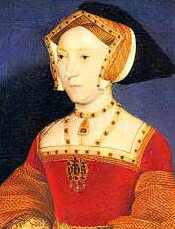
In a bid for power, the Duke of Norfolk, head of the Catholic faction at court, flaunted his nubile and attractive niece, Catherine Howard, before the King. Henry was smitten by the exquisite Catherine and had his marriage to " that great Flanders Mare" Anne annulled because she had a pre-contract with the Duke of Lorraine. Anne complied with all her formidable spouse's requests, she wisely agreed to be Henry's " good sister". Despite his past service, Cromwell was brought to the block through the machinations of his enemies.
Anne of Cleves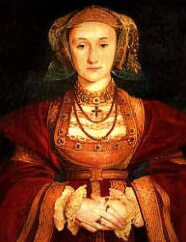
The Fall of Catherine Howard
The King married Catherine Howard and well pleased with his new wife, the doting Henry regained some of his lost youth with his lively and vivacious fifth spouse and thanked God for his new found happiness "after sundry troubles of mind which had happened to us by marriages".
His " rose without a thorn", unknown to Henry, had already acquired a reputation, promiscuous from adolescence and manipulated into a marriage with an obese and decidedly middle-aged man to satisfy her uncle's lust for power and influence, she foolishly and dangerously continued to stray after her marriage. The Protestant element at court seized their chance and pounced. The king was informed and Catherine, arrested for her affairs, became hysterical. The cuckolded Henry immersed himself in self-pity at his treatment by the woman he had so loved. He announced that of all the wives he had," not one of them had put herself out to be a comfort" to him and woefully cursed his ill-fortune at " meeting with such ill-conditioned wives".
An Act of Attainder, making it treason for any woman of unchaste reputation to marry the king was passed against Queen Catherine and her Lady-in-Waiting, Lady Rochford, had been party to her infidelities. " Few of any ladies now at court would henceforth aspire to such an honour", wrote Chapuys, the Spanish ambassador, in his report of the sorry affair to Spain. The teenage Catherine was tried for high treason and followed her cousin Anne Boleyn to the Tower and the block. She regained her composure before her execution and asked for a block to be brought to her, where she indulged in the macabre exercise of practising laying her neck on it.
Her execution took place on 13 February 1542, she was reported to have " died well". Catherine was buried beside Anne at the chapel of St. Peter ad Vincula within the Tower. In Victorian times, a memorial pavement was laid out to commemorate both these Queens of England and others that were executed on Tower Green and laid to rest in the Chapel of St. Peter ad Vincula.
Katherine Howard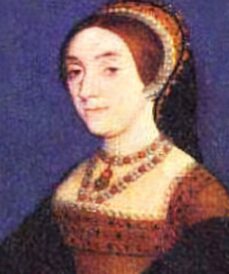
The Last Years
Henry's last marriage to Catherine Parr was a more sensible one. Catherine, an attractive and intelligent woman, was the widow of Lord Latimer. Despite two previous marriages, she had no children of her own, nor was it thought likely that she would produce any. Catherine took a lively interest in Henry's children and their education, she brought them to court and tried to create a family life for them, which had been conspicuously absent before her arrival. The King was now ageing fast and in failing health. He suffered from a suppurating ulcer on his leg, which was extremely painful and had become vastly overweight.
Henry's nephew, King James V of Scotland, had died leaving his baby daughter Mary as his sole heir. Mirrroring the behaviour of his predecessor Edward I, Henry embarked on a policy of forcing the reluctant Scots and Mary of Guise, the Scottish regent to accept a marriage between his son and heir Edward and their infant sovereign, Mary, Queen of Scots, whom he insisted should be brought up at the English court. This "rough wooing" as the Scots referred to his actions, only succeeded in pushing them into renewing the "Auld Alliance" with France.
The Children of Henry VIII
Mary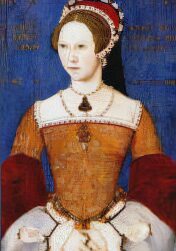 Elizabeth
Elizabeth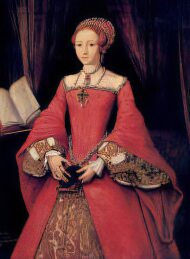 Edward
Edward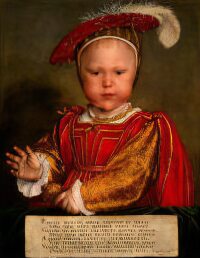
As the king visibly declined, the Catholic and Protestant factions at court struggled to obtain power during the long minority reign which would inevitably follow. Attempts were made to bring about the demise of the Queen, who had strongly Protestant sympathies and was not reluctant to eagerly expound her religious beliefs to her husband. Catherine's enemies pounced and a Bill of Articles, outlining her supposed heresies, was drawn up. Catherine was forewarned of the danger and understandably terrified by the fate of her predecessors, threw herself on her husband's mercy. Henry accepted a highly flattering explanation from her. When her enemies came the next day to arrest her, Chancellor Wriothesley was set upon by the King.
The theory that the King suffered from the venereal disease syphilis, was first put forward about a century after his death. It was later suggested that his three children, Edward VI, Mary I and Elizabeth I also inherited the disease from him. However contemporary accounts contain no mention of the use of mercury, the usual remedy for syphilis at the time, being used to cure Henry's complaint. The King sustained a serious thigh wound during a jousting exercise in 1536. His acutely painful injured leg prevented him from exercising, which in turn led to increasing obesity. Measurements of his armour reveal that, between his 20s and his 50s, the 6ft 1" king's waist grew from 32" to 52", his chest expanded from 39" to 53". Henry also suffered from frequent headaches. As he aged, he showed signs of mental decline, severe depression, a short temper, and possibly personality change. It has been argued that the king may have also had McLeod syndrome, a genetic disorder that occurs in individuals with a Kell-positive antigen blood disorder. This would account for the multiple miscarriages on secondary pregnancies suffered by his wives and would account for the mental instability he demonstrated later in his life. The disease also weakens the musculoskeletal system.
Henry became determined in his last years to safeguard the peaceful succession of his son Edward and set about ruthlessly removing anything that he might perceive to be an obstacle to that aim. Margaret, Countess of Salisbury, the last of the Plantagenets and the daughter of George, Duke of Clarence, was arrested along with other members of her family and imprisoned in the Tower.
The Countess, an indomitable old lady of great courage, determined that nothing was going to be extracted from her. An Act of Attainder was passed against her and she was held in the Tower for two years. The Countess, approaching seventy, was sentenced to death. She walked resolutely to the block on Tower Green, proudly refusing to lay her head on the block, her neck and shoulders were hideously hacked at by a novice executioner before she was decapitated.
Norfolk's son, the Earl of Surrey, was at this time foolish enough to quarter his arms with those of Edward the Confessor, thus boasting of his Plantagenet descent. Henry, of a suspicious turn of mind even at the best of times, struck out savagely. Both Surrey and Norfolk were arrested and sent to the Tower. Surrey was beheaded and Norfolk, under sentence of death, was spared only by the king's death the night before his intended execution.
Henry VIII's Henry's obesity hastened his death at the age of 55, he spent his last days bedridden, although death appeared imminent, as it was treason to predict the King's death, not even Henry's doctors could summon the courage to inform the King. Sir Anthony Denny undertook the perilous task of warning Henry VIII that 'in man's judgement, he was not like to live' and should remember his sins, 'as becometh every good Christian man to do'. Henry responded by saying that he believed that Christ in all His mercy would 'pardon me all my sins, yea, though they were greater than can be.
Henry, at Whitehall, was sinking fast, he asked for Cranmer, but by the time the Archbishop arrived, he was speechless. Cranmer asked for a sign that he put his faith in Christ, at which Henry, struggling for breath, wrung his hand with all the strength he could muster. He died shortly after, in the early hours of 28th January 1547. Those responsible for the smooth handing over of power to Edward VI did not announce his death for three days.
A week later King Henry VIII was buried at St. George's Chapel, Windsor Castle, at his request, with his best-loved queen, Jane Seymour.
The Ancestry of Henry VIII
Henry VIII
Father: Henry VII
Paternal Grandfather: Edmund Tudor,Earl of Richmond
Paternal Great-grandfather: Owen Tudor
Paternal Great-grandmother: Catherine of Valois
Paternal Grandmother: Margaret Beaufort
Paternal Great-grandfather: John Beaufort, Duke of Somerset
Paternal Great-grandmother: Margaret Beauchamp of Bletso
Mother: Elizabeth of York
Maternal Grandfather: Edward IV
Maternal Great-grandfather: Richard Plantagenet, Duke of York
Maternal Great-grandmother: Cecily Neville
Maternal Grandmother: Elizabeth Woodville
Maternal Great-grandfather: Richard Woodville, Earl Rivers
Maternal Great-grandmother: Jacquetta of Luxembourg
The Six Wives of Henry VIII-Genealogy
See also:-
The Tower of London in Tudor times.
External Links
Henry VII PreviousNext
